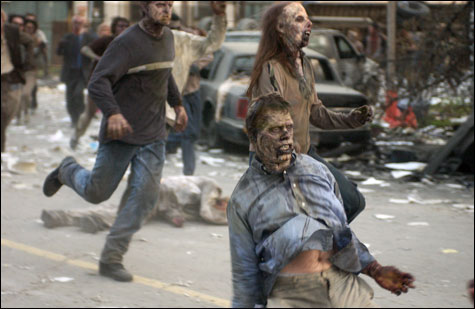
DISMEMBERS ONLY: The zombies run amok in the 2004 remake of Dawn of the Dead by Zack Snyder. |
In his 1954 novel I Am Legend, Richard Matheson conjured up a terrifying scenario: a man-made plague has killed most of humanity. Some of the infected have mutated into grotesque vampires. Only one man, Robert Neville, has escaped untainted. To protect himself against the diseased revenants seeking his blood, he has transformed an LA bungalow into a fortress, stocked with goods and amenities pillaged from the city’s unattended stores. By day he ventures forth, armed with wooden stakes (and, in subsequent movie adaptations, increasingly sophisticated weaponry), to wipe out whatever vampires he comes across. By night he drinks himself insensible.Nightmare? Sounds more like a dream come true for the average fan of the mega-selling, zombie-blasting Resident Evil video game, as well as for a sizable part of the audience that will be frothing at the mouth for I Am Legend, the third movie adaptation of Matheson’s novel made to date. Directed by Francis Lawrence, with Will Smith as Neville, the film is expected to be one of the biggest grossers of the year. Bring on the plague and the mutants! The firepower and booze, the high-tech gizmos and free food!
Previous film versions of the book — The Last Man on Earth (1964) and The Omega Man (1971) — might have been intended, in part, as cautionary tales against human folly and hubris. But nowadays, audiences have been so insulated from the real world of consequences by video games, cable TV, iPods, and cell phones that they might as well be the last man or woman on Earth. (At the very least, it doesn’t seem as if they’d mind if they were.) So they probably won’t be lining up for the latest Legend to be dutifully reminded that AIDS, germ warfare, global terrorism, disastrous climactic change, unforeseen cosmic catastrophe, the Biblically predicted End of Days, Iranian nuclear development, an accidentally triggered atomic war, degenerate liberal intellectuals, or armies of cannibalistic undead are just waiting for a chance to drive the race to extinction. More likely, they’ll expect a graphic indulgence in these fantasies without any guilt or responsibility that would require them to worry too much. (And having just seen the film, which I liked, I can say they might be disappointed, as well.) Like a number of similar films released recently — including 28 Weeks Later, Children of Men, The Invasion, and The Mist — Legend, in part, reflects a culture both alienated from reality by media images and voyeuristically drawn to fantasies of death and destruction.
These sole-survivor-of-doom movies are a symptom of the times, as they were before when previous editions of Matheson’s story shared the screen with a host of other films about being the sole survivor of mass human extinction. Each of these films mirrors the subconscious of the audiences who watched them.